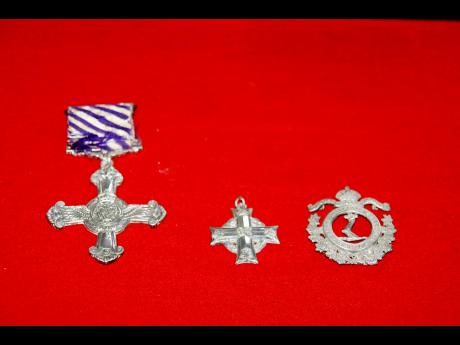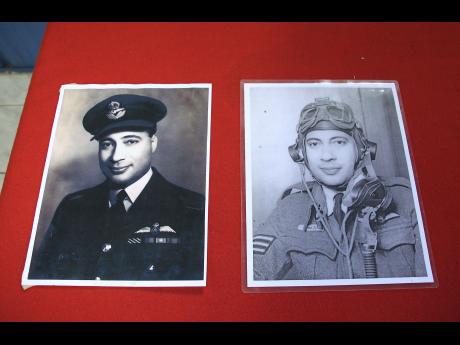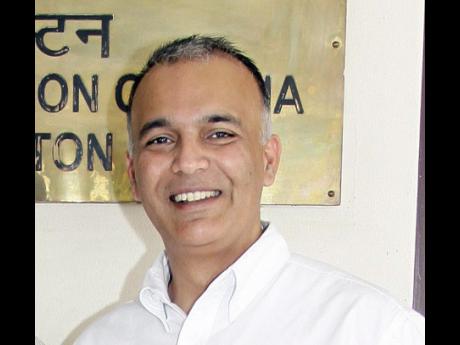Saluting heroes of the sky
"We should not forget the sacrifices made the by brave men in the World Wars," said Major (Retd.) Johanna Lewin. Somewhere in the vast expanse of serene blue skies, in an era before dependency on artificial intelligence, human instincts ruled the roost. thinking out of the box was not an option. Stories of the soldiers from Jamaica and the wider Caribbean who took to the skies and fought for 'motherland' often go untold.
"Not known to many youngsters," Lewin said. "Those who lived through the years 1939 to 1945 and those who know the struggles of World War II, the Jamaica Branch (of Royal Air Forces Association RAFA) remains the symbol of the courage of a group of young Jamaicans who were brave enough to risk their lives in mortal combat."
What is poignant is that memories of that point in time are as obscure as the yellowing pages of a book which, though holding a place of pride on a bookshelf, is covered with a film of dust.
Roll the clock back to August 4, 1914, the British Empire went to war with Germany - 15,600 volunteers from the Caribbean colonies, including Jamaica, joined the British West Indies Regiment. They served in France, Palestine, Egypt and Italy. Some of the volunteers served with the Royal Flying Corps (RFC) and the Royal Naval Air Service these arms were merged on April 1, 1918 to form the Royal Air Force.
Significantly, Sergeant William Robinson Clarke, a Jamaican, joined RFC in July 1915, and gained wings (got his pilot's badge) on April 1, 1917 in essence, he was part of the RAF since its inception. He was the first British black pilot for the RFC who served the force in World War I and World War II.
He would later serve as the life president of RAFA Jamaica.
In 1940, the skies were grey over Europe. Sounds of the rotors whizzing, sirens blaring, bombs exploding, humanity was at the edge. There was loss of lives and material, and around this time, to replenish the depleting numbers of planes.
The"Planes for Britain" fund was started by Alec Gordon to raise funds for a single bomber for the 'motherland'.
This money was raised in two weeks and with the overwhelming show of support, and it was then decided that the fund would further seek to provide for an entire squadron.
It was a subscription drive by The Daily Gleaner that raised £75,000, which helped to purchase 12 Blenheim bombers. These bombers were used by the 139 (Jamaica) Squadron, they flew low level to penetrate German lines and conduct daylight bombings.
According to the RAFA, a Pathfinder Force was later established when it was found that 80 per cent of bombs were missing their targets. The Pathfinders guided larger bombers and dropped flares over the targets, which the larger planes bombed.
Accuracy was key
For their safety, the Pathfinders relied on accuracy of navigation and speed in evading anti-aircraft guns. The only West Indian to serve in the squadron was Ulric Cross, a navigator from Trinidad and Tobago who became its squadron leader.
The Jamaica Squadron was the first to cross German lines on a reconnaissance mission. Cross himself flew 30 missions over Germany and received the Distinguished Service Order for exceptional navigation the Distinguished Flying Cross for gallantry.
Then there is one of the many stories of bravery.
Jamaican Harold Lester Lindo enlisted with the Royal Canadian Air Force in Ottawa on June 20, 1940. He trained and was commissioned on March 14, 1941 and left for overseas deployment on March 26, 1941.
On 15 February 1944, flying with the 103 Squadron in Lancaster MKIII- no 363 pm A, the aircraft took off at 17: 10 hrs from RAF Elsham Wolds in north Lincolnshire for a bombing mission on Berlin. The aircraft was shot by a night fighter at 22:58 hrs crashing into Wadenzee, east of Texel, Holland, killing the entire crew of seven.
His name is inscribed with 20,000 other Royal Canadian Air Forces soldiers at the Runnymeade Memorial, London.
"These are stories that need to be told to every generation," said Capt. Staci-Marie Dehaney, curator, Jamaica Military Museum. "There is a reiteration of the sense of pride and the fact that soldiers from Jamaica and the Caribbean had a major role in play in these turning points of history."
Lewin, chairman of RAFA Jamaica 580 Branch, and the first woman helicopter pilot of the Jamaica Defence Force, said it is but fitting that the supreme sacrifices of these soldiers have been etched in history.
In July, at the Centenary Services of the Royal Air Force at Westminster Abbey in London, RAFA Jamaica 580 Branch was represented by James Croach, who is 93 and one of the few surviving veterans who served in the Royal Air Force during World War II.
"It was very important that RAFA Jamaica was represented at the event," Lewin said. "It is recognition of service and sacrifice of Jamaicans in both World Wars and the significant contributions these veterans made to Jamaica on their return."
RAFA was formed in 1930 as Comrades of the Royal Air Forces Association, it later merged with the Women's Royal Air Forces Association in 1943, and the name was changed to the Royal Air Forces Association.
The Jamaica Branch of RAFA was established 16 August 1946 and held as its objective, to continue to foster good fellowship and a spirit of service among its members to perpetuate the comradeship formed during the service in the air forces.
Over the years the organisation has continued this focus on service above self, preserving the memories of those who made the ultimate sacrifice, and most importantly being there to support each other and each other's families.
"These are formidable achievements," Capt Dehaney said, "which after more than 100 years are relevant, and they should continue to inspire not only Jamaicans, but people across the world for time immemorial."
Lest anyone forget, it is the sacrifices of the brave men and women, that helped to rewrite chapters of history, and they would continue to be rewritten time to brush off the dust on those proverbial books and let their words shine through.







